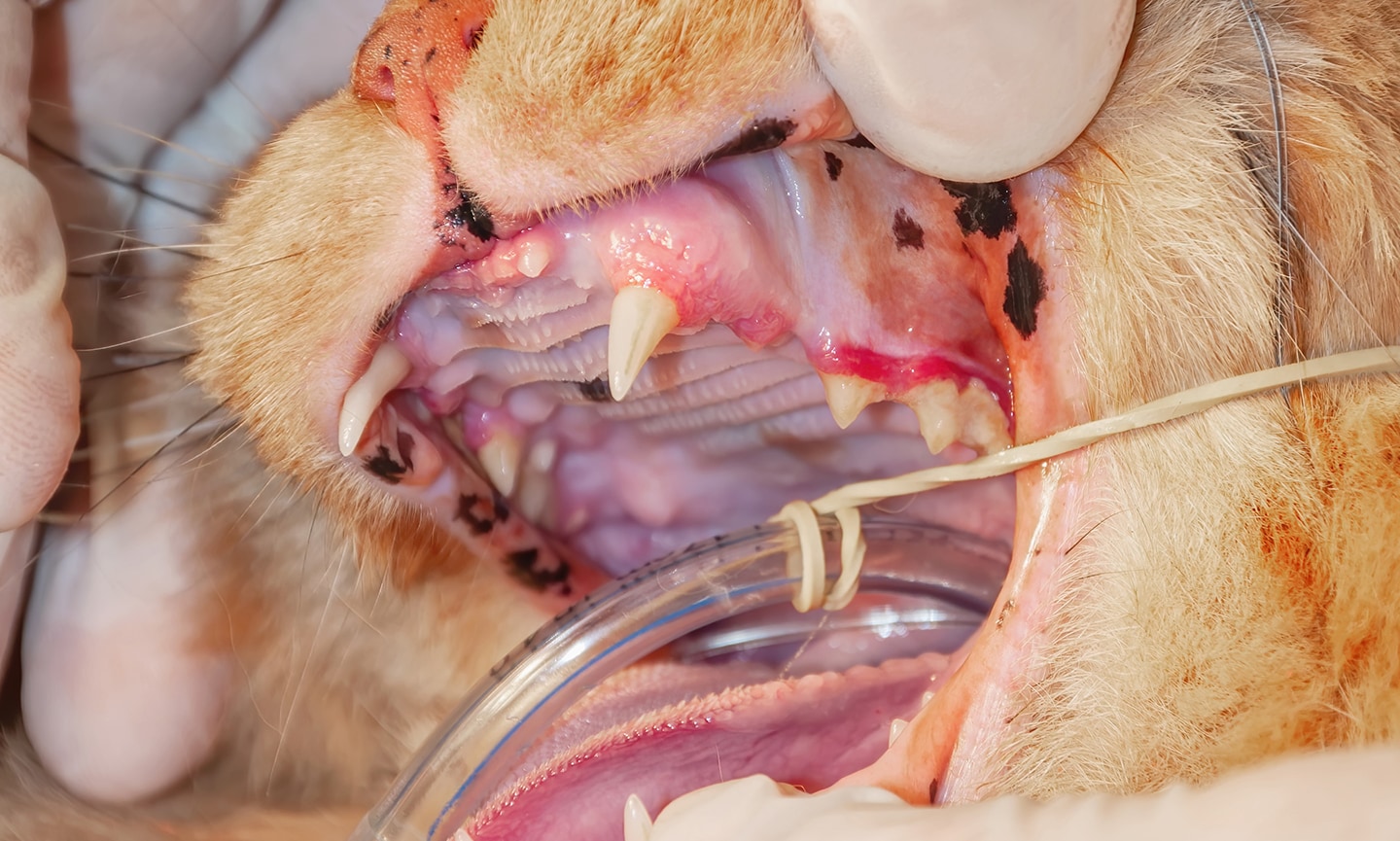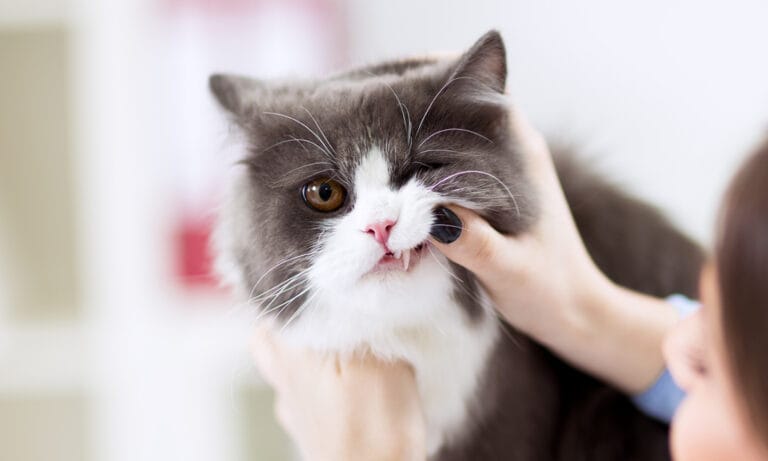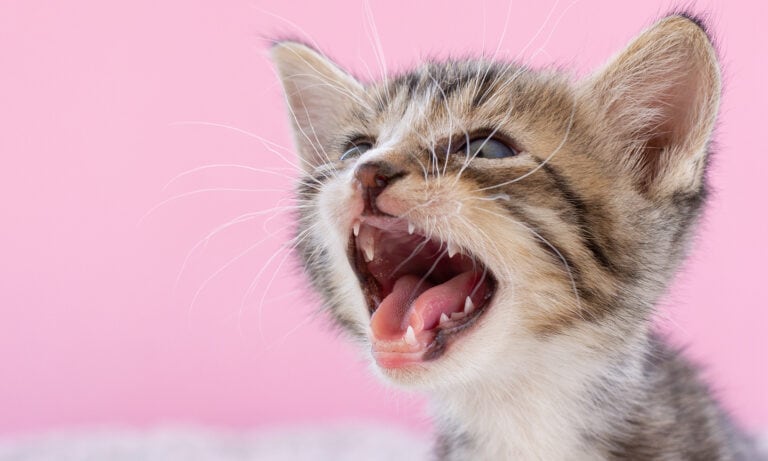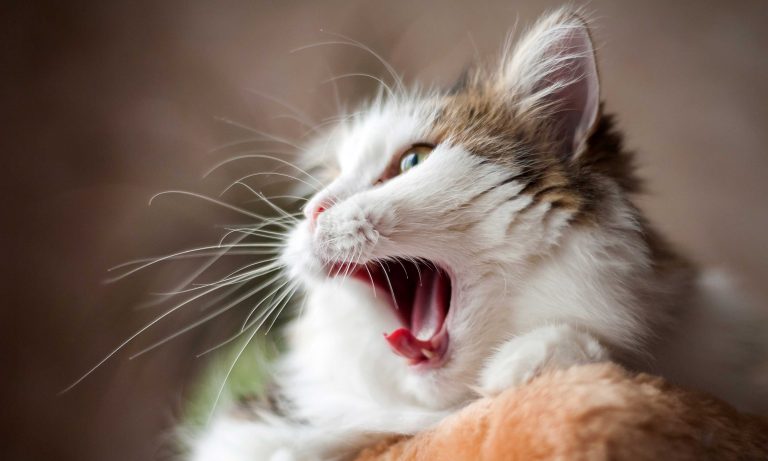Unlike humans, cats can’t tell us when something hurts or feels off in their mouth. That’s why it’s crucial for pet parents to recognize the subtle signs of dental issues in cats (such as difficulty eating and bad breath) and get them prompt dental care.
We spoke to vet experts to uncover the specific behaviors and symptoms that could indicate your kitty is facing dental issues.
In This Guide:
14 Signs of Unhealthy Cat Teeth
Always be on the lookout for the following signs of dental problems in cats. Early detection is key to preventing more serious issues.
1. Bad Breath
“A strong or offensive mouth odor—as opposed to normal ‘kitty breath’—indicates that something is amiss in your cat’s mouth,” says Sarah Wooten, DVM, CVJ, a veterinarian in Silverthorne, Colorado.
This bad breath could stem from a range of issues, including periodontal disease, tooth resorption, infections, cancer, or various other mouth, tooth or gum disorders, she adds. Each of these conditions can lead to discomfort or pain for your feline friend.
2. Red or Inflamed Gums

Photo: Oleksandr Hryvul/iStock/Getty Images Plus
“Healthy gums should be pink and firm,” says Becca Boronat, MV, CAWA, a veterinarian at Best Friends Animal Society in Charleston, South Carolina. “If you notice redness, inflammation or swelling along the gumline, it could indicate gingivitis or other dental issues.”
3. Difficulty Eating or Loss of Appetite
“If you notice your cat avoiding their dry cat food, chewing on only one side of their mouth, dropping food from their mouth while eating (also called quidding) or vomiting unchewed food, you might be seeing signs of a cat in pain,” says Dr. Wooten.
4. Tartar or Plaque

Photo: Nils Jacobi/iStock/Getty Images Plus
A buildup of plaque and tartar on your cat’s teeth is more than just an aesthetic issue—it’s a health concern. When you spot a yellowish-brown buildup, especially near the gum line, it’s a sign that your cat might be developing dental problems, says Dr. Boronat.
Left unchecked, this can lead to more serious conditions like periodontal disease. Regular dental checkups and teeth cleanings are crucial in managing this buildup and maintaining your cat’s oral health.
5. Drooling
Drooling while eating is a common indicator of oral issues in cats. Particularly concerning is when the drool or your cat’s water dish contains traces of blood, says Dr. Wooten. This symptom can result from conditions like gingivitis (inflammation of the gums), cervical line lesions (abnormalities or damage in the region involving the neck of the tooth), or other sources of dental pain.
Drooling that occurs even when your cat is not eating could also signal underlying problems, such as toxin ingestion, that warrant immediate veterinary attention.
6. Tooth Loss or Tooth Mobility
“In severe cases, you may notice loose teeth or missing teeth,” says Dr. Boronat. “This can occur due to advanced periodontal disease.”
Signs of tooth loss or tooth mobility in your cat can include discreet signs, like trouble biting down, or more apparent signs, like visibly wiggling or missing teeth.
7. Chattering
Chattering, characterized by a shaking or quivering jaw, is commonly seen in cats with resorptive lesions on their teeth, says Dr. Wooten. These painful lesions, where specialized cells absorb tooth structure, can create cavity-like holes, erode teeth or transform tooth roots into bone.
This type of chattering typically happens when a cat eats, washes their face or grooms, and is triggered by sharp pain emanating from the tooth root, says Dr. Wooten. It can sometimes be loud enough to hear, and chattering during eating or grooming is always abnormal and indicative of discomfort or pain in their mouth.
8. Pawing at or Rubbing Their Face
“Usually seen with acute pain, a cat may try to get the pain out of their mouth by pawing at it,” says Dr. Wooten. They may also rub their face against furniture or other objects in an effort to find some relief, she adds. This behavior is a clear sign that your kitty is experiencing oral pain.
9. Excessive Yawning or Teeth Grinding
A cat experiencing severe oral pain may have trouble closing their mouth completely, says Dr. Wooten. “This could result in excessive yawning or teeth grinding.”
10. Head Shaking or Tilt
Although often linked to ear issues, head shaking, or a head tilt can also indicate dental pain in cats. A cat suffering from dental disease might frequently shake their head or tilt it towards the side of the mouth where the issue is located, says Dr. Wooten.
“If head shaking happens in conjunction with drooling or another sign on this list, dental problems are the prime suspects,” she adds.
11. Facial Swelling
“In some cases, dental disease can lead to facial swelling, particularly around the eyes or cheeks,” says Dr. Boronat.
This swelling can be a sign of an underlying infection or abscess stemming from a dental issue.
12. Decrease in Self-Grooming
Conditions like gingivitis can make grooming a painful task for your cat. If you observe a decrease in grooming frequency, or if your cat’s coat starts to appear greasy, flaky, matted, or unkempt, this could be a sign that they’re experiencing discomfort somewhere, possibly in their mouth, says Dr. Wooten.
13. Pulling Away or Meowing When Touched Near the Mouth
Cats with dental pain caused by issues such as resorptive lesions or gingivitis may react negatively when their mouth area is touched, says Dr. Wooten. They might pull away, meow, hiss, swipe at you, or try to bite you.
This change in behavior, especially in a typically docile or affectionate cat, is a strong indicator of dental pain.
14. Changes in Normal Behavior
Any changes in a cat’s usual behavior can be a subtle sign of dental issues. This may manifest as increased irritability, decreased playfulness, or changes in social interactions with humans and other pets.
Cats experiencing dental pain might also seek out more secluded spots to rest, avoiding their typical favorite places. Such shifts in behavior, especially when combined with any other signs of dental distress, should prompt a closer examination of your cat’s oral health.
Common Cat Dental Issues
- Gingivitis: Often the first stage of cat periodontal disease, gingivitis is a reversible inflammation of the gums around the teeth, says Dr. Boronat. It commonly stems from the accumulation of plaque and tartar on one or more teeth, she adds. Plaque and tartar develop over time due to the accumulation of food residue and bacteria in the mouth. Gingivitis is characterized by red, swollen gums and can escalate to more severe dental conditions if not treated promptly.
- Periodontitis: If gingivitis is left unchecked, it can progress to periodontitis. This condition, which starts with plaque buildup, is an inflammatory disease that progressively destroys the tissues that attach the tooth, says Dr. Boronat. It can eventually affect the underlying bone, causing loose teeth or tooth loss. The damage caused by periodontitis is irreversible, but progression of the disease can be stopped with proper treatment.
- Tooth resorption: This condition occurs when a cat’s tooth structure begins to break down or gets absorbed back into their body, leading to tooth loss and significant discomfort. The cause of tooth resorption in cats is currently unknown.
When To See a Vet
While routine, at-home dental care can significantly contribute to your cat’s oral health, it’s not enough. Your cat also needs professional dental cleanings.
The frequency of professional dental cleanings for cats can vary based on individual factors such as age, breed, overall health, and the condition of their teeth and gums. Typically, veterinarians advise an annual dental checkup and suggest preventive cleanings every one to two years.
Professional cleanings are essential for removing hardened tartar that at-home brushing simply can’t tackle.
It’s crucial to remain vigilant for any signs and symptoms of dental issues between these cleanings. If you notice any of the above symptoms, take your kitty in for a checkup as soon as possible. Prompt treatment is key to preventing discomfort, mitigating the risk of worsening dental health, and helping maintain your cat’s overall health and quality of life.
Treating Cat Dental Issues
The approach to addressing dental issues in cats varies depending on the specific problem they’re facing:
- For hardened tartar buildup and gingivitis, a thorough cleaning under anesthesia is typically the first step. This process removes plaque and tartar on the teeth and below the gum line. Following the removal (scaling) process, the teeth are polished to smooth out any microscopic scratches, which helps slow the accumulation of new plaque. The application of a dental sealer might also be suggested to further reduce plaque buildup.
- For periodontitis, your vet will focus on eliminating plaque and mineral deposits through scaling and polishing the teeth, aiming to preserve as many teeth as possible. However, in advanced cases of periodontitis, it may be necessary to extract (remove surgically) one or several teeth to effectively address the condition.
- For tooth resorption, treatment may entail surgically removing the affected tooth and, sometimes, its root.
How To Keep Your Cat’s Teeth Healthy
Maintaining your cat’s dental hygiene between professional cleanings is crucial for their overall health. Here are some effective ways to ensure your feline friend’s teeth stay in tip-top condition.
Regular Brushing
Brush your cat’s teeth at least every other day—but preferably every day—using a cat-specific toothpaste and toothbrush. This reduces plaque and prevents tartar buildup. Do not use human toothpaste on your kitty, as many brands contain ingredients that can be harmful to pets, such as fluoride, detergents and artificial sweeteners like xylitol.
Before starting a regular brushing routine, get your cat comfortable with having their mouth handled and gradually introduce them to the brushing process.
In a pinch, dental wipes, such as Petkin® Plaque Toothwipes™, can also be used to remove icky buildup.
Give Your Cat Dental Treats
Cat dental chews not only make for a yummy snack but also help scrape the plaque off your kitty’s chompers. Follow the directions on the package to determine how many treats are acceptable to give your cat.Consider Dental Toys
Cat dental toys help gently clean your kitty’s teeth while they chew. A couple kitty favorites include Catstages™ Straw-Babies Catnip Dental Cat Toy and Catstages™ Plaque Away Pretzel Cat Toy.
Put Dental Additives in Your Cat’s Water and Food
Water and food additives, which mix into your cat’s drinking water or wet cat food, contain enzymes that break down plaque. These additives are usually tasteless and can be a simple and discreet way to improve your kitty’s dental health.
A few trusted water additives include Oxyfresh®, Dental Fresh® and Oratene®.
And a couple favorite food additives include ProDen® PlaqueOff® Powder and Vibeful™ Dental Health Powder Supplement.
Consider a Specially Formulated Dental Diet
For cats prone to dental issues, your veterinarian might suggest a cat food formulated to support dental health, such as Hill’s® Prescription Diet® t/d® Dental Care dry cat food or Royal Canin® Veterinary Diet Dental dry cat food. These dry foods are designed to reduce plaque and tartar buildup.
Monitor Your Cat for Signs of Dental Issues
Start regularly looking in your cat’s mouth at a young age to familiarize yourself with what’s normal. This also helps your kitty become accustomed to humans looking inside their mouth.
Monitor your cat for signs of dental problems, such as bad breath, difficulty eating or head shaking. Detecting problems early is key to preventing more serious issues.
Do Product Research
“There are several dental products on the market, but not all of them are equal or promote the necessary effects to prevent plaque buildup,” says Dr. Boronat. As such, she recommends referencing the Veterinary Oral Health Council (VOHC) for information about the effectiveness of specific brands of cat oral health products, including toothbrushes, toothpaste, chews, and food and water additives. Products awarded a VOHC seal have been proven through clinical trials to decrease plaque or tartar formation by at least 10 to 20%, says Dr. Boronat.
However, it’s important to note that a 10 to 20% reduction in plaque or tartar alone will not protect your cat from periodontal disease. Rather, prevention requires a multi-pronged approach, including diet, dental chew treats, brushing and professional care.
It’s also important to note that products without a VOHC seal may also be effective, as not all product manufacturers choose to go through the lengthy verification process. Referencing customer reviews can help you make informed choices.
FAQs About Unhealthy Cat Teeth
Q:How common is cat dental disease?
A:Dental disease is very common in cats, with studies showing that 85% of cats aged 3 years and older have some form of dental disease.
Q:What does dental disease look like in cats?
A:In cats, dental disease can manifest as red or swollen gums and tartar buildup on the teeth. In more advanced stages, you might notice loose or missing teeth and bleeding gums.
Q:Why is my cat losing teeth?
A:If your cat is losing teeth, it could be due to several factors. Periodontal disease and tooth resorption are common culprits. Other reasons include trauma, poor nutrition, age-related wear and tear, and infectious diseases like feline immunodeficiency virus (FIV) or feline leukemia virus (FeLV). It’s important to consult a veterinarian to diagnose the specific cause and receive proper treatment.
Q:Can a cat live with bad teeth?
A:While dental disease in cats is not immediately fatal, it’s not good for their health or quality of life. Dental issues can lead to significant pain and infection, and can even affect organs over time if bacteria from the mouth spread through the body. If left untreated, dental disease can become life-threatening. Therefore, addressing dental problems promptly and effectively is crucial for your cat’s well-being.
Like this story? Check out more of our favorite reads:
Share:






















